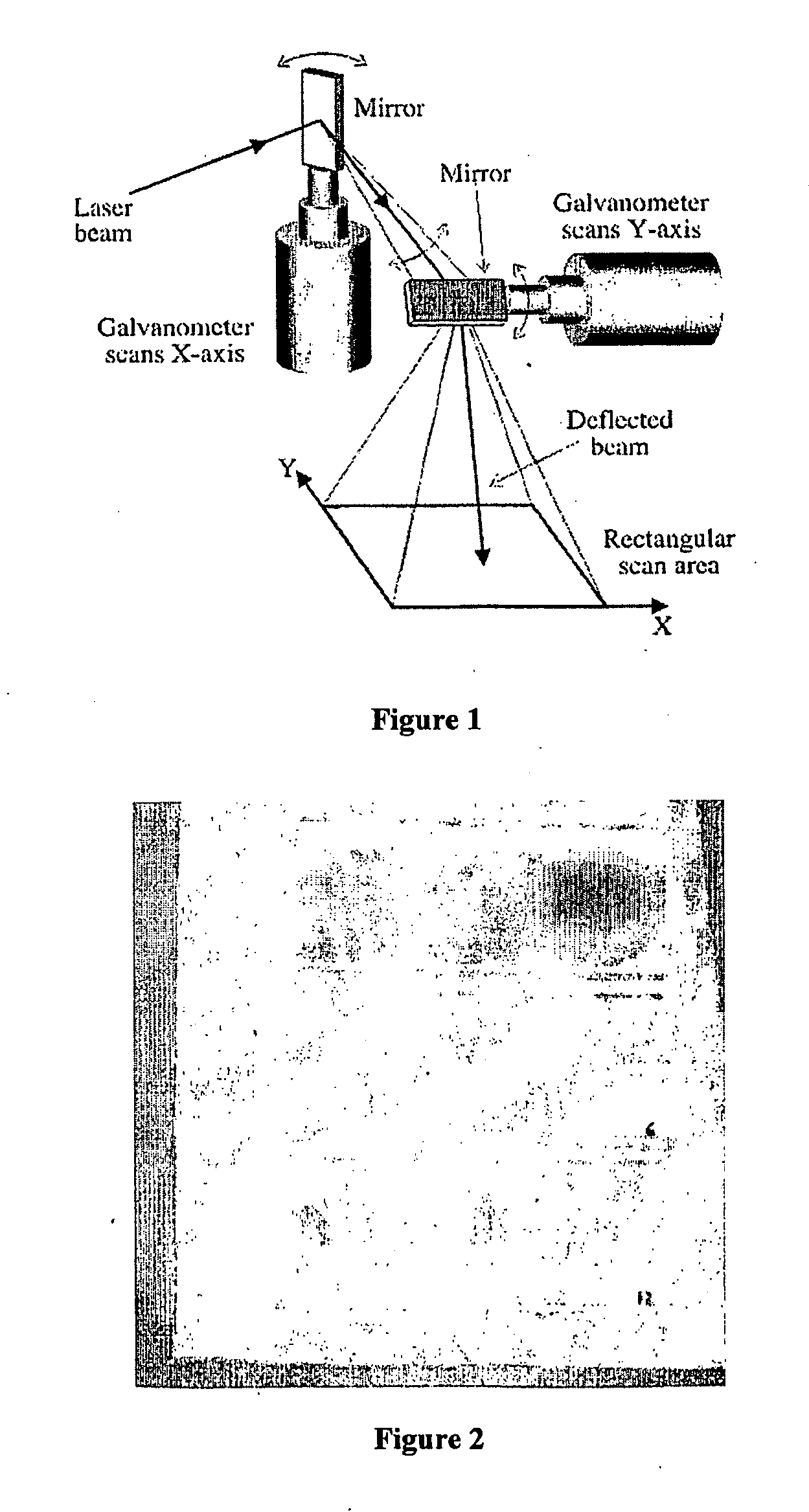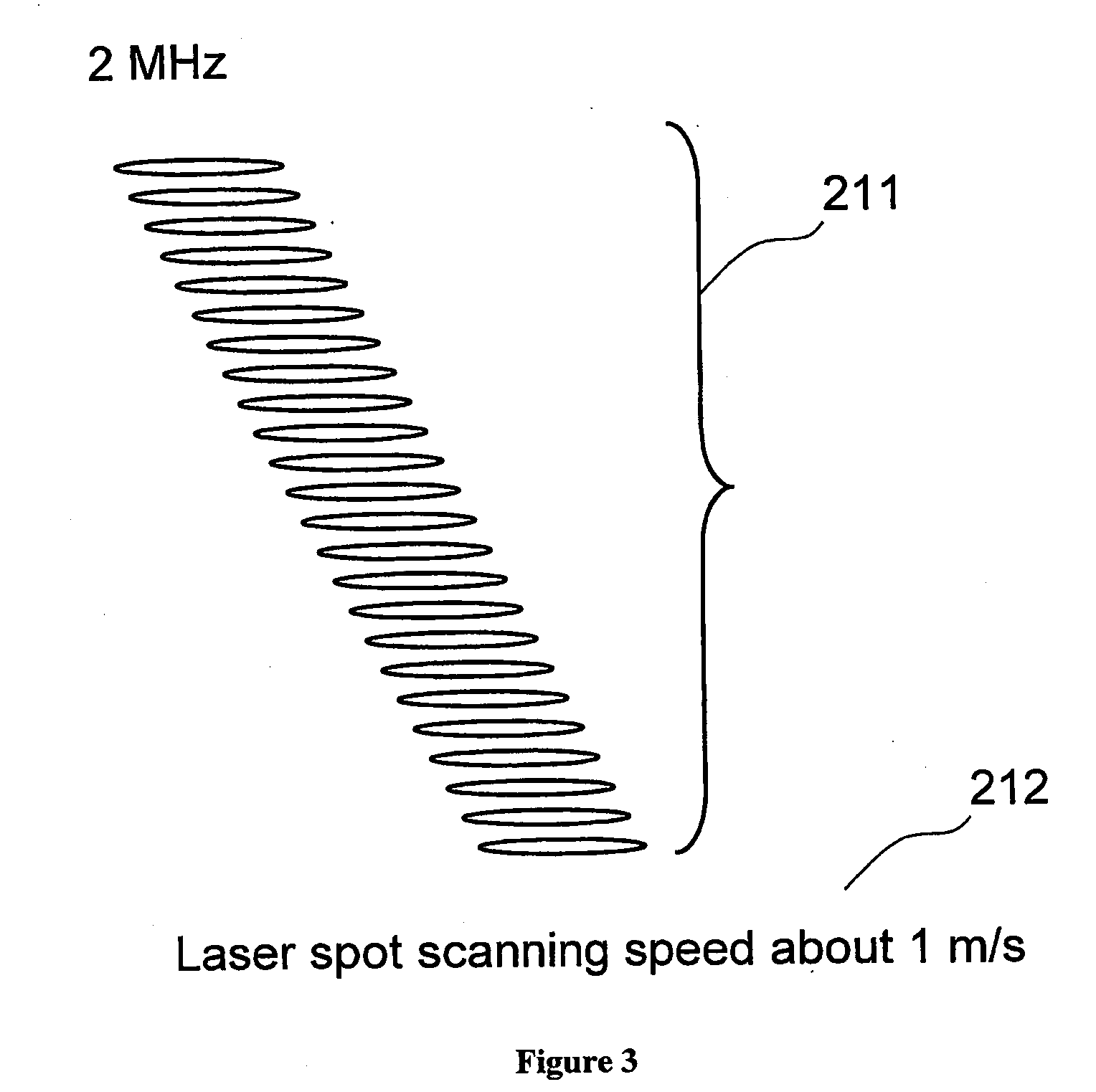Coating on a fiber substrate and a coated fiber product
a technology of coating and fiber substrate, which is applied in the direction of film/foil adhesives, instruments, manufacturing tools, etc., can solve the problems of large vacuum pumping period time- and energy-consuming, inability to achieve industrial scale coating of most of the present fiber products, and inability to clean up after vacuuming
- Summary
- Abstract
- Description
- Claims
- Application Information
AI Technical Summary
Benefits of technology
Problems solved by technology
Method used
Image
Examples
examples
Example to Demonstrate Known Art Problems
Laser Technology
[0118]FIG. 2 represents the ITO-coating on polycarbonate sheet (˜100 mm×30 mm) produced by employing a prior art optical scanner, namely vibrating mirror (galvo-scanner), in different ITO thin-film thicknesses (30 nm, 60 nm and 90 nm). Although the ITO-coating is not deposited on metal substrate, the picture clearly demonstrates some of the problems associated with employing vibrating mirror as an optical scanner especially in ultra short pulsed laser deposition (USPLD) but also in laser assisted coatings in general. As a vibrating mirror changes its direction of angular movement at its end positions, and due to moment inertia, the angular velocity of the mirror is not constant near to its end positions. Due to vibrating movement, the mirror continuously brakes up and stops before speeding up again, causing thus irregular treatment of the target material at the edges of the scanned area. As it can be seen from FIG. 2, this in ...
example of invention
1
[0123]FIG. 9a demonstrates a target material ablated with pico-second-range pulsed laser employing rotating scanner with speed accomplishing the ablation of target material with slight overlapping of adjacent pulses, avoiding the problems associated with prior art galvano-scanners. FIG. 9b shows enlarged picture of one part of the ablated material, clearly demonstrating the smooth and controlled ablation of material on both x- and y-axis and thus, generation of high quality, particle-free plasma and further, high quality thin-films and coatings. FIG. 9c demonstrates one example of possible x- and y-dimensions of one single ablation spot achieved by one or few pulses. Here, it can be clearly seen, that the invention accomplishes the ablation of material in a manner wherein the width of the ablated spot is always much bigger than the depth of the ablated spot area. Theoretically, the possible particles (if they would be generated) could now have a maximum size of the spot depth. The ...
example 1
[0127]An ark of copy paper (80 g / m2, white, uncoated) comprising 100 mm×100 mm was coated by ablating sintered carbon with pulse repetition rate of 4 MHz, pulse energy 5 μJ, pulse length 20 ps and the distance between the target material and surface to be coated was 60 mm. The vacuum level was 10−5 atmospheres during the coating process. The process resulted in a uniform pale-brown coloured, transparent coating. The coating thickness was approximately 210 nm.
PUM
| Property | Measurement | Unit |
|---|---|---|
| surface area | aaaaa | aaaaa |
| surface area | aaaaa | aaaaa |
| surface area | aaaaa | aaaaa |
Abstract
Description
Claims
Application Information
 Login to View More
Login to View More - R&D
- Intellectual Property
- Life Sciences
- Materials
- Tech Scout
- Unparalleled Data Quality
- Higher Quality Content
- 60% Fewer Hallucinations
Browse by: Latest US Patents, China's latest patents, Technical Efficacy Thesaurus, Application Domain, Technology Topic, Popular Technical Reports.
© 2025 PatSnap. All rights reserved.Legal|Privacy policy|Modern Slavery Act Transparency Statement|Sitemap|About US| Contact US: help@patsnap.com



